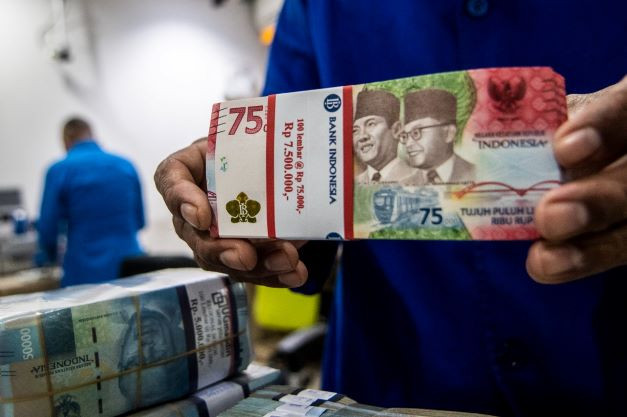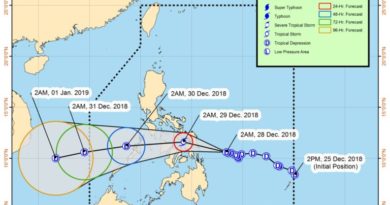OP-ED OPINION | ACADEMIA- A common currency in ASEAN will benefit citizens
Cash only: An employee arranges rupiah banknotes at Bank Mandiri in Jakarta on June 23, 2022. The currencies of Southeast Asia and the world have been taking on the mighty US dollar this year amid the US Federal Reserves’ rate hikes. (Antara/Muhammad Adimaja)
Vijay Eswaran Hong Kong, China
Wed, September 28, 2022

It’s fair to say there exists a level of social and economic inequality within ASEAN.
Following the 1997 Asian currency crisis that exposed ASEAN’s vulnerability to cross-border capital flows, the region has undergone a significant transformation from a bloc of mostly underdeveloped and developing countries to one with the world’s most dynamic economies collectively.
>
Ads by:
Memento Maxima Digital Marketing
@[email protected]
SPACE RESERVE FOR ADVERTISEMENT
However, rapid development has led to rising income disparity and high levels of inequality which undermine the fight against poverty, slow down economic growth, and threaten social cohesion.
It was after the Asian financial crisis that then Malaysia prime minister
.Mahathir Mohamad floated the idea of having a common currency for the region.
>
Ads by:
Memento Maxima Digital Marketing
@[email protected]
SPACE RESERVE FOR ADVERTISEMENT
,
Recently, in 2019, he once again reiterated that proposal, stating that ASEAN should “adopt a common trading currency, not to be used locally but for the purpose of settling of trade” that would be pegged to gold, to create a currency that replaces the US dollar as the region’s vehicle currency in regional trade and investment.
Why the push for a common currency in ASEAN?
All we need to do is look at Europe, where the euro is the best example of a common currency.
In the 20 years since its implementation, the euro has contributed to the stability, competitiveness, and prosperity of European economies.
>
Ads by:
Memento Maxima Digital Marketing
@[email protected]
SPACE RESERVE FOR ADVERTISEMENT
.

The single currency has helped to keep prices stable and protected the euro area economies from the exchange rate volatility.
However, while Europe has shown that a common currency does and can work in a globalized world, there needs to be caution, as evidenced by the European sovereign debt crisis, which was indirectly brought about by the Euro’s single monetary policy that did not fit local economic conditions.
>
Ads by:
Memento Maxima Digital Marketing
@[email protected]
SPACE RESERVE FOR ADVERTISEMENT
.
Under floating exchange rate regimes, currencies tend to be more volatile than is warranted by the economic fundamentals of an economy.
This is especially true of small developing economies with thin capital markets.
Many Asian emerging market economies (EMEs) hold significant US dollar-denominated reserve assets as a means of self-insurance against potential financial instability.
With this reliance on the US dollar, Asian countries are highly exposed to shocks arising from changes in the economic policy and conditions related to the United States.
>
Ads by:
Memento Maxima Digital Marketing
@[email protected]
SPACE RESERVE FOR ADVERTISEMENT
.
Our economies are subject to “global financial cycles” in capital flows, asset prices, and credit growth.
Developing countries with large unhedged foreign currency liabilities, therefore, often “fear to float”.
Monetary policies in such countries tend to be pro-cyclical rather than counter-cyclical.
Belying the expectations of advocates of floating exchange rate regimes, flexible exchange rates have often become a source of shocks rather than shock absorbers.
>
Ads by:
Memento Maxima Digital Marketing
@[email protected]
SPACE RESERVE FOR ADVERTISEMENT
.
The risks of mispricing currencies under floating exchange rate regimes have been substantial, and disproportionate volatility in exchange rates has led to increased uncertainty, lower trade, lesser investment, and reduced overall economic growth.
There have been steps taken toward providing greater monetary integration in the region.
In 2000, ASEAN plus China, Japan, and South Korea (ASEAN+3) created a network of bilateral currency swap arrangements intended to provide short-term liquidity in a future crisis.
>
Ads by:
Memento Maxima Digital Marketing
@[email protected]
SPACE RESERVE FOR ADVERTISEMENT
.
That network eventually became a more formal facility known as the Chiang Mai Initiative Multilateralization (CMIM).
The ASEAN+3 Macroeconomic Research Office (AMRO) was formed in 2011 to conduct regional surveillance and support the initiative.
Like a common language facilitates effective communication among people, a common currency could help eliminate exchange-rate uncertainty, guard against speculative attacks and raise ASEAN’s bargaining power.
Long-term interest rates may potentially decline and become less volatile.
A common currency will also facilitate greater intraregional trade flows, thus putting pressure on prices and resulting in cheaper goods and services.
Individuals will also benefit since they will no longer have to change money when traveling within the region and be able to compare prices more readily.
>
Ads by:
Memento Maxima Digital Marketing
@[email protected]
SPACE RESERVE FOR ADVERTISEMENT
.
For example, in a country such as Thailand, located in the middle of ASEAN, a common currency could further intra-ASEAN trade interests for the country.
Services such as health care, education, and tourism will potentially become more affordable to other ASEAN citizens increasing demand in these sectors.
Manpower and talent can be easily interchanged, leading to greater employment opportunities and increased economic integration between the ASEAN countries.
With ASEAN on track to becoming the fourth largest economy in the world by 2030, it is tempting to think that a single ASEAN currency could become one of the major currencies in the world.
While already taking up almost 13.7 percent of foreign direct investments, a common market could further enhance ASEAN’s role as a global player.
>
Ads by:
Memento Maxima Digital Marketing
@[email protected]
SPACE RESERVE FOR ADVERTISEMENT
.
However, sustaining a common currency at a practical level might be more difficult than adopting it.
According to the Asian Development Bank report, factors that presently hinder the adoption include the diversity in the level of economic development across countries, weaknesses in the financial sectors of many countries, an inadequacy of “resource pooling mechanisms,” and the relevant institutions that are required for a currency union.
Most importantly, the region lacks the political preconditions for monetary cooperation, the bank says.
The large diversity of economic development adds to the complexity.
>
Ads by:
Memento Maxima Digital Marketing
@[email protected]
SPACE RESERVE FOR ADVERTISEMENT
.
Singapore, the most developed of all, has a per capita income of almost 60 times that of Myanmar, with Vietnam, Indonesia, and Malaysia being among the better-performing states among most of the ASEAN members.
A common currency needs robust financial systems and markets, as well as strong institutional support.
Not all ASEAN countries have such institutions to deal with the threats to the financial sector, which have increased in recent years.
Then there is the lack of control over national monetary and fiscal policies, restricting the governments’ sovereignty and autonomy.
>
Ads by:
Memento Maxima Digital Marketing
@[email protected]
SPACE RESERVE FOR ADVERTISEMENT
Not all ASEAN members are willing to accept this in a heartbeat.
Perhaps the implementation of a digital currency, which countries such as Singapore and Cambodia are currently exploring to enhance payment efficiency, could be the key to solving the issues posed above.
Digital currencies and other innovations in payment systems could increase the speed of domestic and cross-border transactions, reduce transaction costs, and eventually broaden access to the financial system by poor and rural households.
With ASEAN having room to grow by adopting digital currency, the benefit of having a digital currency will help deepen regional economic integration.
***
The writer is founder and executive chairman of QI Group.
This article was published in thejakartapost.com with the title “A common currency in ASEAN will benefit citizens – Academia – The Jakarta Post”. Click to read: https://www.thejakartapost.com/opinion/2022/09/28/a-common-currency-in-asean-will-benefit-citizens.html.











